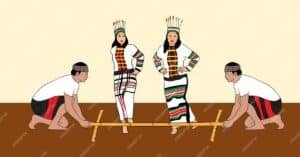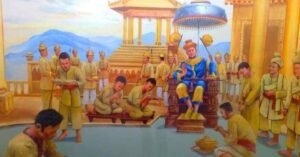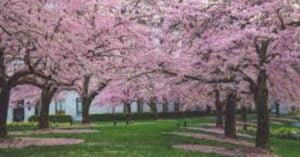The term “Mizo” is a combination of two words, “mi” and “zo,” which when brought together, translates to “highlander” or “hill people.” This name aptly reflects the geographical and cultural identity of the various indigenous tribes of Mizoram and neighboring regions. It is a testament to their unique way of life, closely intertwined with the elevated landscapes that characterize the state of Mizoram in northeastern India.
Mizoram is primarily a tribal state, with most of its tribes belonging to the Kuki-Chin group within the Tibeto-Burman family. The population of Mizoram in 2011 Census has been 10,97,206. Of them, 10,36,115 are Scheduled Tribes (STs) constituting 94.43 per cent of the total population of the state. The majority of these tribes share a common ancestry and speak languages or dialects that are closely related. Furthermore, a significant number of them have embraced Christianity, which has fostered mutual understanding and cooperation among these tribes, despite historical antagonisms prior to their conversion to Christianity. In contrast, the Chakmas stand out distinctly among these tribes due to their adherence to Buddhism. Moreover, their level of education and overall socio-economic performance remains comparatively low.
Introduction of Tribes of Mizoram
On the outset, we must understand the term ‘Mizo’ and who are considered the tribes of Mizoram? The term “Mizo” is a broad and inclusive label that encompasses several sub-tribes within Mizoram, all of which share similar cultural traits and a common historical background. In this context, “Mizo” can be seen as a unifying factor that bridges the gap between the diverse tribal communities in Mizoram. Nowadays, there are a lot of conflicting views and ideas as to the use of the term ‘Mizo. Most people always put all the sub- tribal groups such as Hmar, Paite, Vaiphei, Biate, Pawi, Lakher etc. within the term ‘Mizo’ which these groups of tribe do not agree to. But in the truest sense of the term, Mizo has a number of sub-tribal groups and all these groups including Lushai are the different sub-tribes of Mizo. In simple terms, the state of Mizoram has lots of tribes living in its border; however, we consider only those tribes as tribes of Mizoram who share similar cultural traits and a common historical background. In this context, the major tribes of Mizoram are: Mizo (Lushai), Pawi (Lai), Lakher (Mara) and Chakma
Lushai Tribes of Mizoram
The Lushai tribe, the largest among the tribes of Mizoram, are particularly concentrated in the Aizawl and Lunglei districts. The term “Lushai” is derived from “Lusei,” though it was popularized as “Lushai” by British administrators. Despite the official term, the Lushai people prefer “Lusei” among themselves. They, along with various Mizo sub-tribes, migrated to present-day Mizoram during the 17th and 18th centuries, primarily from Myanmar. Within the Lusei community, there are six chief clans and ten commoner clans, each with several sub-clans. The Sailo clan emerged as the predominant chieftainship lineage, consolidating their rule and bringing other clans and sub-tribes under their authority.
The Lusei dialect, known as Duhlian, has become a lingua franca among Mizo sub-tribes due to its similarity and adoption by Christian missionaries for education and religious purposes. Linguist G.A Grierson classifies it within the Kuki-Chin group of the Tibeto-Burman family.
Before British colonial rule, a hierarchical social structure existed, with the Sailo clan occupying the highest social status. The social pyramid comprised the chief, advisors, exempted families, agricultural experts, priests, blacksmiths, and commoners, who paid various tributes to the village chiefs. Below the common people were the “bawi,” who were private subjects of chiefs and could buy back their freedom.
The British colonization, starting in the 1840s and fully establishing in the 1890s, significantly influenced Lusei society, as did the efforts of Christian missionaries who converted the Lushai and other tribes to Mizoram to Christianity by the 1930s. Although Christianity transformed their way of life, some customary practices have persisted, such as the payment of bride-price.
Lusei society revolves around patrilocal joint families with patrilineal descent and inheritance. In the past, the youngest son inherited family property, but this changed after British rule to favor primogeniture. The influence of modern economic practices and wealth accumulation has modified inheritance practices.
In marriages, negotiation and the payment of bride-price, traditionally in terms of mithun, remain significant. However, the distribution of bride-price serves more as a ritual than a means of creating or reaffirming kinship ties in today’s context.
Lushai (Mizo) literacy is notably high, with 95.6 percent literacy rate. Agriculture is the primary economic activity, and the traditional shifting cultivation method, called jhum cultivation, still dominates, although people are diversifying into other economic activities. The Mautam famine of 1959 and the subsequent insurgency had a lasting impact on the Lushai tribe, particularly the forced relocation of villages for counter-insurgency measures. Peace was eventually established with a memorandum of settlement in 1986, but the experience of insurgency and village grouping has had a lasting impact on Lushai society, transforming traditional social relations and village structures.
Pawi (Lai) Tribe
According to the 2011 Census, the Pawi (Lai) population in Mizoram amounts to 51,406, approximately 5% of the total state population. Concentrated in the southern part of Mizoram around Phawngpui (Blue Mountain), a significant number of Pawi people live across the international border in the Chin State of Myanmar. Lawngtlai District houses the main population of Pawi tribes, with Lawngtlai town serving as the seat of the Pawi (Lai) Autonomous District Council. The Pawi tribes are predominantly Christians (99.28%) with a high literacy rate of 91.6%. Their habitation in Mizoram exclusively consists of hill ranges, with villages perched on hilltops at elevations ranging from 2,500 to 4,000 feet. The region enjoys a pleasant climate, not excessively hot in summer or too cold in winter.
Despite various Pawi clans and sub-clans, they primarily speak four dialects: Khuofo and Thantlang within Mizoram, and Halkha (Haka) and Laizo in Myanmar. Their dialect is classified as Tibeto-Burman and was reduced to written form with the Roman script by early missionaries. Presently, most Pawi people in interior villages speak the Duhlian (Mizo) dialect, as it was promoted as the medium of instruction by missionaries and used in Bible translations.
The Pawi population has entirely embraced Christianity, replacing traditional religious rites and ceremonies with Christian practices. Christian festivities like Christmas, New Year, and Easter Sunday are significant, while some traditional folk dances and songs have been revived with government and cultural organization support.
Regarding marriage, bride price remains a custom, and marriages are solemnized in the church according to Christian rituals. The age of marriage for girls typically ranges from sixteen to eighteen, and for men, around twenty-five. While monogamy is the usual marriage pattern, polygamy was practiced in the past, primarily among chiefs and wealthy men. The Pawi society follows a patrilocal residence pattern, and divorce implications vary based on the party seeking it.
Economically, the Pawi, like other tribes of Mizoram, rely on land and forests. Shifting (jhum) cultivation on hill slopes is their primary agricultural activity. Individual land ownership is not common, with village councils overseeing land allocation for shifting cultivation each year.
Lakher (Mara) Tribe
The Lakher (Mara) people, recognized as a scheduled tribe in India, are primarily native to northeastern India, particularly in the Mara Autonomous District Council of Mizoram. They also have a significant presence in the southeastern part of Myanmar, bordering Chin State and Rakhine State. Formerly known as the Lakher by outsiders, the name “Mara” was officially adopted in the List of Scheduled Tribes in Mizoram state in 1978, replacing the older name. According to the 2011 Census of India, the Lakher (Mara) tribe in Mizoram comprises 42,855 individuals, representing 4.13% of Mizoram’s total population.
The Lakher (Mara) tribes of Mizoram belong to the Kuki-Chin group of the Tibeto-Burman family. Their migration history traces back to Southern China, with subsequent settlements in Northern Burma and, eventually, their present location, where they have resided for approximately three centuries.
Within the Mara Autonomous District, there are 50 villages and 59 village councils. The tribe was known by various names to outsiders, including Mara, Lakher, Shendu, Maring, Zyu, Tlosai, Khongzai, etc. They refer to themselves as “Maras.” Over the years, they have experienced changes in administration and political structure. British rule brought stability and the abolition of slavery, leading to a shift from barter to currency as a medium of exchange. The demise of village chiefs’ authority began during this period.
After independence in 1953, the Lakher (Mara) area was merged with the Lai area to form an autonomous region named “Pawi-Lakher Region” under the Sixth schedule of the Indian Constitution. After the 1972 reorganization of North East India, the Pawi-Lakher Regional Council was divided into the Lai (Pawi), Mara (Lakher), and Chakma Autonomous District Councils. Saiha serves as the capital of the Mara (Lakher) Autonomous District Council. The Mara Autonomous District Council is responsible for preserving and promoting the Mara language, which is used as the medium of instruction in elementary schools up to class six within its jurisdiction.
The Lakher (Mara) tribe is composed of five principal sub-groups: Tlosaih-Siaha, Zyhno, Hawthai, Chapi, and Vytu. Each sub-group occupies a distinct territory, with numerous clans within each sub-group. Their society was traditionally organized with a hierarchical structure, including chief clans, patrician clans, and commoner clans, with variations in bride prices based on clan status. However, the hierarchical structure has diminished in relevance with the spread of Christianity.
The majority of the Lakher (Mara) population resides in rural areas, fostering a strong sense of community and kinship bonds. They practice patrilocal residence after marriage, and their society follows patrilineal descent, where the father is the head of the family. Monogamy is the standard form of marriage among the Lakher (Maras), although chiefs and patrician clans have practiced polygamy. Marriages were traditionally arranged, with varying complexities and costs based on clan status. Bride prices among the Lakher (Maras) are relatively high. With the arrival of missionaries in 1907, the Lakher (Maras) adopted Christianity, leading to significant changes in their culture and society. They abandoned traditional superstitions and practices, embracing Western clothing and values while retaining some customs and traditions.
Chakma Tribes of Mizoram
The Chakmas, also known as the Changma, are the second-largest scheduled tribes of Mizoram, constituting 9.35 percent of the total scheduled tribe population. They are primarily settled in the southwestern and western parts of Mizoram, bordering Tripura state and Bangladesh. In 1972, the Chakmas were granted an autonomous district council under the Sixth Schedule of the Indian Constitution to preserve their culture and traditions, with the council headquartered in Kamalanagar (or Chawngte) in the southwestern part of Mizoram.
The Chakmas are more recent immigrants into Mizoram, originating from the Chittagong hill tracts of Bangladesh. Anthropologists and linguists identify them as belonging to the Tibeto-Burman group of the Mongolian race. However, their language, Chakma, is now considered part of the Southeastern Bengali branch of the Eastern Indo-Aryan language family, with some suggesting that they have adopted a variant of Bengali.
The Chakmas practice a form of Buddhism known as Theravada Buddhism, with influences from Hinduism and traditional religion. They worship Hindu deities alongside Buddhist practices, offering sacrifices to appease spirits, despite contradicting Buddhist beliefs.
Chakma society is organized into clans (gojas) further subdivided into sub-clans (guttis). Strict endogamy is practiced, with marriage within the same clan or sub-clan considered a serious offense. Parents typically arrange marriages, with the bride price negotiated between families. Recent years have seen the bride price reduced to a symbolic practice. Polygyny is accepted but rare, and remarriage after the death of a spouse is allowed.
Families among the Chakmas can be of both nuclear and extended types, with increasing popularity of nuclear families. The eldest male son takes on the role of the family head after the father’s death. Inheritance entails an equal share for each son, and fathers may also give shares to daughters at their discretion.
Chakmas in Mizoram are predominantly found in rural areas, with only 0.8 percent residing in urban areas. Their traditional occupation is agriculture, involving shifting and semi-permanent cultivation, with no individual land ownership. They practice mutual respect for each other’s fields. Some Chakmas have shifted to the labor market, with educated individuals taking white-collar jobs. However, many remain in farming due to limited employment opportunities and educational facilities. The Chakma tribe has one of the lowest literacy rates among the tribes ofMizoram, with male and female literacy standing at 56.2 percent and 33.6 percent, respectively, according to the 2010 Census of India.














